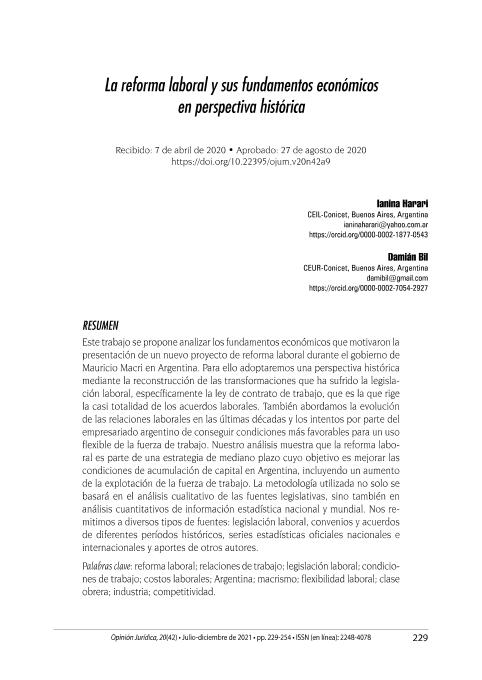Artículo
Este trabajo se propone analizar los fundamentos económicos que motivaron la presentación de un nuevo proyecto de reforma laboral durante el gobierno de Mauricio Macri en Argentina. Para ello adoptaremos una perspectiva histórica mediante la reconstrucción de las transformaciones que ha sufrido la legislación laboral, específicamente la ley de contrato de trabajo, que es la que rige la casi totalidad de los acuerdos laborales. También abordamos la evolución de las relaciones laborales en las últimas décadas y los intentos por parte del empresariado argentino de conseguir condiciones más favorables para un uso flexible de la fuerza de trabajo. Nuestro análisis muestra que la reforma laboral es parte de una estrategia de mediano plazo cuyo objetivo es mejorar las condiciones de acumulación de capital en Argentina, incluyendo un aumento de la explotación de la fuerza de trabajo. La metodología utilizada no solo se basará en el análisis cualitativo de las fuentes legislativas, sino también en análisis cuantitativos de información estadística nacional y mundial. Nos remitimos a diversos tipos de fuentes: legislación laboral, convenios y acuerdos de diferentes períodos históricos, series estadísticas oficiales nacionales e internacionales y aportes de otros autores. This Works analyzes the economic foundation that motivated the presentation of a new Project of labor reform during the government of Argentinean President Mauricio Macri. For that, the article employs a historical perspective through the reconstruction of the transformations suffered by the labor legislation, specifically by the working contract law, which is the one that rules almost all of the labor agreement. The article also tackles the evolution of the labor relationships in the last decade and the initiatives of Argentinean entrepreneurship of achieving more favorable conditions for more flexible use of the workforce. The analysis shows that the labor reform is part of a mid-term strategy for improving the conditions for capital accumulation in Argentina, including an increase in the exploitation of the workforce. The methodology employed is based not only on the qualitative analysis of the legislation sources but also quantitative analysis of the national and worldwide statistical information. Several types of sources are used for that, such as labor legislation, agreements and covenants of different historical periods, national and international statistic series, and contributions made by other authors.
La reforma laboral y sus fundamentos económicos en perspectiva histórica
Título:
Labor Reform and its Economic Foundations in a Historical Perspective
Fecha de publicación:
19/05/2021
Editorial:
Universidad de Medellín
Revista:
Opinión Jurídica
ISSN:
1692-2530
e-ISSN:
2248-4078
Idioma:
Español
Tipo de recurso:
Artículo publicado
Clasificación temática:
Resumen
Palabras clave:
REFORMA
,
LABORAL
,
LEGISLACION
,
FLEXIBILIDAD
Archivos asociados
Licencia
Identificadores
Colecciones
Articulos(CEUR)
Articulos de CENTRO DE ESTUDIOS URBANOS Y REGIONALES
Articulos de CENTRO DE ESTUDIOS URBANOS Y REGIONALES
Citación
Harari, Ianina; Bil, Damián Andrés; La reforma laboral y sus fundamentos económicos en perspectiva histórica; Universidad de Medellín; Opinión Jurídica; 20; 42; 19-5-2021; 229-254
Compartir
Altmétricas




